the sea turtle project
Here’s the story about how a simple idea to help save baby sea turtles was inspired, developed, created, and implemented… all in a few weeks… in time to help save baby sea turtles THIS SEASON!
It’s thanks to Amber Kuehn, marine biologist and head of Sea Turtle Patrol HHI, and her educational efforts through the Turtle Talks she gives that I had the information that inspired this idea, which she was willing to take further to test!
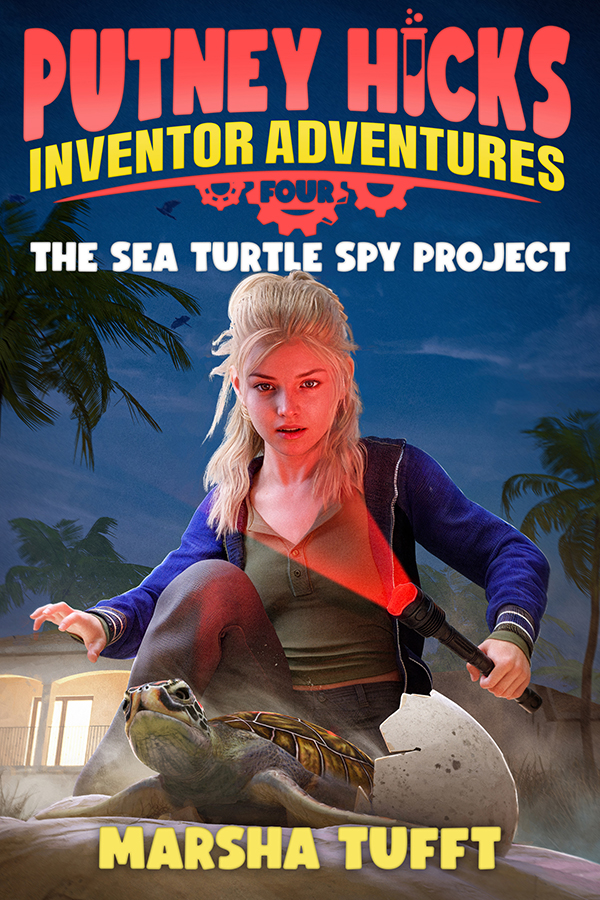
the inspiration & the research
I wanted to incorporate a sea turtle theme in the fourth book of my Putney Hicks Inventor Adventures series, which are problem-solving STEM adventures (STEM = science, technology, engineering, math).
I’d read about Stumpy, a three-legged sea turtle that needed help to dig her nest, and when that miracle occurred (in the form of help by Amber Kuehn, marine biologist and head of Sea Turtle Patrol HHI) only to have all the babies lost due to misorientation – heading inland towards artificial lights, instead of out to sea – I wanted to tell her story in my book.
This year, we added a trip to Hilton Head Island in July… peak sea turtle nesting season, and I was able to do a lot of research first-hand.
I started with daily beach walks, usually on the beach by 5 am… hoping to catch sight of a loggerhead sea turtle nesting (a bit unrealistic), but I did get to witness two sea turtle nest relocations by Sea Turtle Patrol volunteers… I learned a lot and got some great photos, like the one at left. I also got to bounce some plot ideas off them… and realized I needed to rethink them.
Even better, I attended two turtle talks at Dunes House given by Amber Kuehn and learned so much. I’m an engineer and a problem-solver… and those talks took root in me. One day it hit me… what if I could come up with a solution to help save baby sea turtles “Just In Time” (JIT)? What if I could make a difference, this year? The first two nests to hatch occurred while we were in HH… we still had the bulk of the season to go!
I came up with a couple potentially viable ideas. When I reached out to Amber, she gave me insights which allowed me to refine them further and send her a prototype… which has now been approved by SC Department of Natural Resources for use and has already saved baby sea turtle lives. How cool is that?
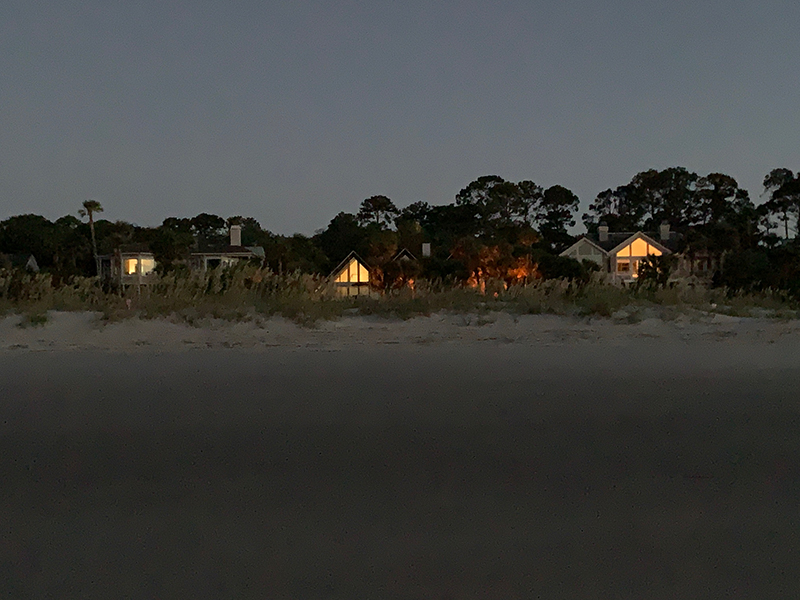


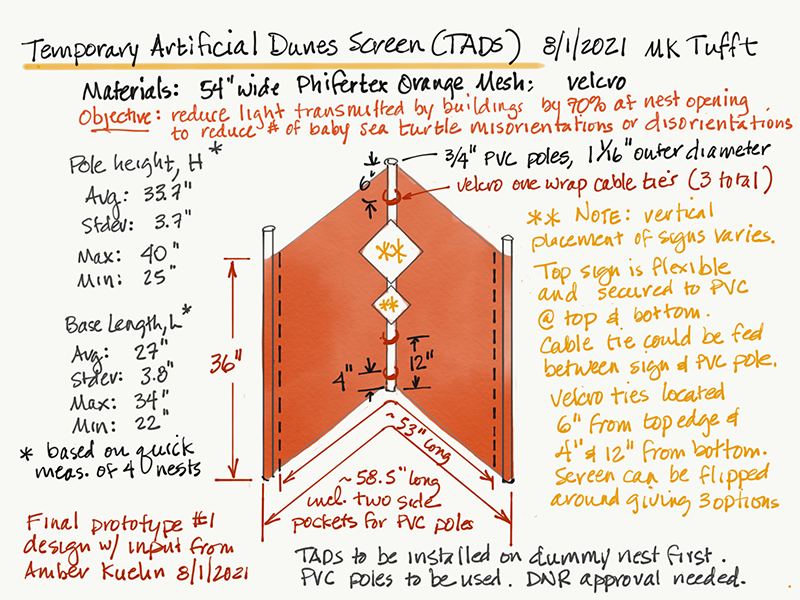
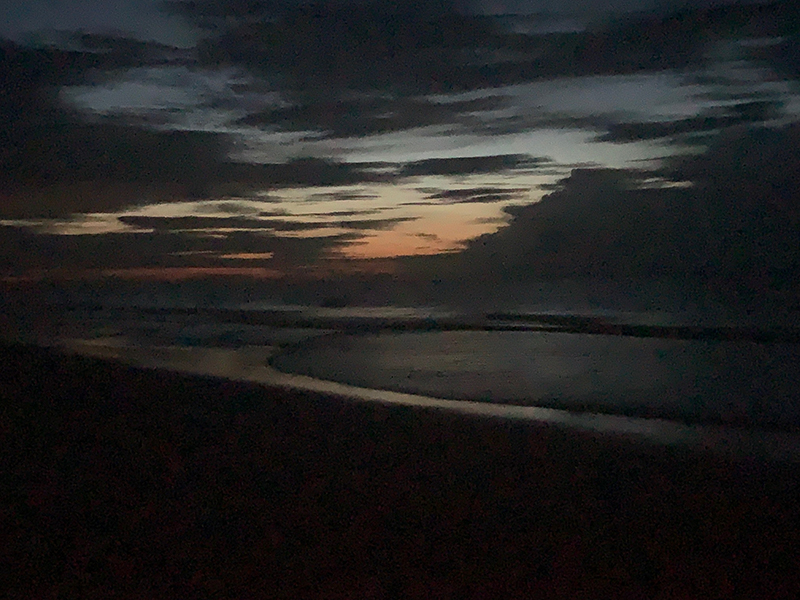
Sometimes a little idea can have a big impact... TADS - temporary artificial dunes screen
I had two ideas: the first was identification and mapping of lighting code violators, to notify them about turning their lights off at night.
The second was a bit flakier… and was inspired by Amber’s description of loss of dunes, and the trend towards building taller houses, hotels, and other beach front developments resulting in sea turtle misorientations.
If the lighting code was not effective in changing behaviors… maybe there was a way to reduce the amount of light reaching the entrance of the nest. A screen of some type.
Two things were in my favor: I knew Sea Turtle Patrol tracked the nests, plus there’s a physical change in the sand above the nest entrance about ten days before hatching… you’ll see a depression in the sand that looks like a bowling ball had rested there. So, we wouldn’t have to shield every nest, we could target those most at risk which are getting ready to hatch. The second: besides being an engineer and a problem-solver, I also have sewing and design skills… and happened to have the perfect material on hand for this particular challenge: Pfifertex mesh screen fabric.
It gets windy on the beach, so I figured a mesh screen would be less likely to be blown over, ripping poles out, than one made from solid fabric. I used a light meter to measure the reduction in light transmitted by this mesh, and it was ~ 70%. I figured that might be enough to tilt the odds in the baby sea turtles’ favor.
My first idea was to build a large PVC frame, but that would require staking… and be very prone to getting blown over. Finally, the day before we left to return home, I came up with the idea of something smaller that could be attached directly to the nest poles already in use. I needed some data, so I walked down to the beach, tape measure in hand, and measured pole heights and side lengths for four nests. I figured that was enough to give me a feel for the variation in data of the nests… I’d watched Sea Turtle Patrol volunteers measure where to place the poles during the two nest relocations, so I knew it wasn’t random!
I still had to figure out dimensions for making the prototypes, and how to attach them to the poles… currently 1 PVC pole and two bamboo poles were being used, with caution tape wrapped around. The simplest idea would be to have a sleeve on each end that could slide over the end poles. I was also trying to figure out how to optimize the use of the mesh material, which is 54″ wide… not quite as long as I wanted. But since it’s a game of angles (and the taller the item, the longer the shadow it will cast), I didn’t want to take it down to 27″ high… it can be a long walk to the ocean at low tide for a baby sea turtle. I was shooting for something closer to 36″.
I decided to try out my rapid prototyping skills, and built a PVC frame using the same diameter PVC as the nest poles. I thought orange mesh would be best for the screens – more visible. I mocked up a quick prototype to check my idea for attachment options around the center PVC pole with the warning signs – velcro one wrap cable ties stitched onto the mesh at different distances from the top and bottom. I was not sure about dimensions and attachment options, and wanted to get input from Amber before going further. I figured the first step would be to make a prototype and install it on a dummy nest to be sure it was stable.
When I reached out to Amber, she arranged a Zoom call for us to talk. The great news… although we were unsure how effective my idea would be, she said they had lots of PVC poles they could use for the other two sides, no need to worry about velcro tabs to reach around the caution tape. A simple sleeve that could slide over the end poles would work, and make everything so much easier to attach, remove, and store later.
Above left is a photo of my first prototype, showing baby turtle tracks headed in the right direction (towards the ocean!) and not the houses behind it.
Not only did Amber Kuehn get approval from SC Department of Natural Resources to use it, but it worked! She even got funding for me to make 30 more nest screens for use this year–2022. The new screens are royal blue.
I’d like to thank all the Sea Turtle Patrol volunteers who graciously answered my questions and helped to educate me while they worked, especially Kym, Carol, Skylar, and Lauren. I’d also like to thank the Turtle Trackers who tirelessly patrol the beach, fill in sand pits, etc. to make it safe for our sea turtles, and who help organize the Turtle Talks I attended at Dunes House. Special thanks to Turtle Tracker Becky who introduced me to Amber, and also shared some of her photos and videos. You don’t have to be a full-time resident to be a Turtle Tracker and help!
If you’d like to help sea turtles on Hilton Head, please consider donating to Sea Turtle Patrol or Turtle Trackers! Sea Turtle Patrol HHI also offers nest dedications.
For more information about Sea Turtle Patrol HHI and Turtle Trackers HHI, please visit their websites!
The image gallery below shows one of my initial concept sketches and first prototype (testing the center pole attachment system), followed by updated sketches and an actual prototype now in use!
The higher the light source, the shorter the shadow created by dunes… so lights on tall hotels and condominiums are especially troublesome.
For info on sea turtle-friendly lighting options, check out this video and remember to keep it low, keep it shielded, and keep it long (wavelengths of 650 nm or longer):
Baby Turtle Tracks!
hatchling release from 8/14/2022 nest inventory!
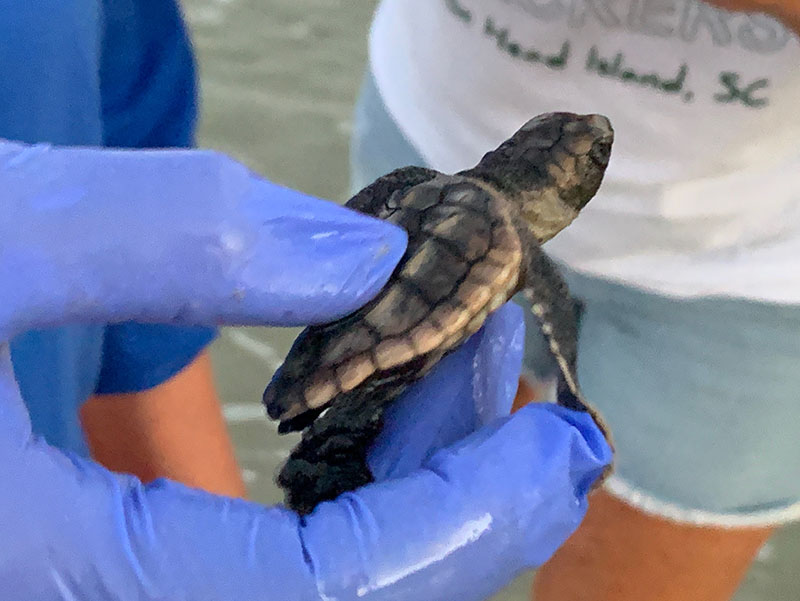
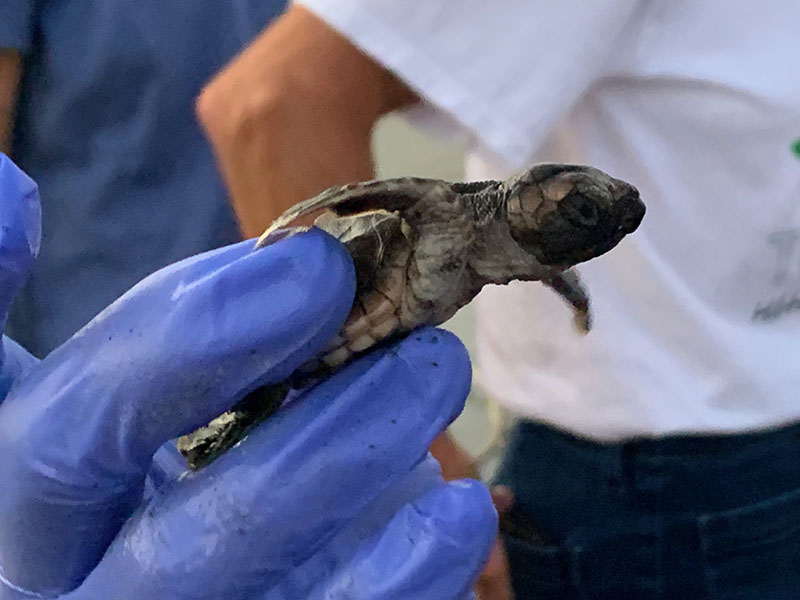
Dunes, beach, & turtle tracks!
Nest relocation photos - May 23, 2022
These are some photos of a sea turtle nest found on May 23, 2022. This nest had to be relocated above the high tide line.
Sea Turtle Patrol Hilton Head Island patrols the beach every morning during nesting season beginning at 5 am. When they find turtle tracks, they probe to find the nest. Occasionally they will declare a false crawl (turtle did not lay eggs). If the nest is in a safe location–above the high tide line-they will take a shell DNA sample of one egg, then put up poles to mark the nest location.
Many times, the nest will be laid on sand below the King Tide line (highest of the high tides). In these cases, STPHHI will relocate the nest to higher ground. This has to be done within the first 24 hours of the eggs being laid. After that, the embryo will attach to the shell and will stop development if there is any rotation of the egg. That’s why STPHHI had to patrol daily. They also take detailed GPS readings. In the even that nest poles are removed, they can use the GPS data to find the nest again and put a new set of poles up. The poles are important because they mark the location of the nest, protecting it from accidental damage by people enjoying the beach.
snorkeling with sea turtles!
Here are a few of my favorite underwater sea turtle photos, taken while snorkeling on St. Barths and St. John islands. The majority of the pics are of green sea turtles, but I did get a few of a hawksbill sea turtle I stumbled upon while snorkeling on St. John… these pics are among my favorites because the tiny fish remind me of the brush strokes in a Van Gogh painting, and I even did a wall quilt from one of these photos!
I took the photos myself, and did the best I could to correct the color balance by shooting a white strip of duct tape on the top of my left fin. Hey–I’m an engineer, not a professional photographer! Thanks to playing underwater hockey, I did get into underwater photography as a hobby.
